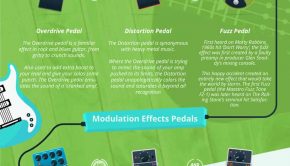The big impact of technology on guitarists
When people think of the instruments and amps that guitarists use, they think of a simple guitar plugged into a classic guitar amp, maybe a few pedals here and there. However, much like any other group, guitarists have been heavily impacted in an explosion of affordable high tech options and accessories over the last few years.
Of course, the one thing new tech can’t do for you is learn the guitar any quicker, and guitarists are notorious for suffering from a condition known as GAS – guitar acquisition syndrome.
However, for the guitarist who wants to forge new paths, or even just make things a little easier, there are a wealth of accessories and upgrades available to satisfy their needs.
Modern Guitars
Truth be told, guitars really haven’t come a long way since electric guitars were all but standardized in the 60s. There have been small advances such as guitar pickups with active circuits (to give a more distorted output – great for metal), and some out there one-off creations such as guitars with midi built in. However, by and large, guitars are as they have been since at the latest the early 80s.
However, in the last few years, there have been some new guitar related tech items that have caught on to make guitarist’s lives easier.
One example would be the Evertune bridge. The Evertune is just a series of springs and levers that replaces a conventional guitar bridge, but it’s set up in such a way that it keeps the guitar completely in tune at all times. This is a game changer for gigging musicians who typically find themselves tuning between every song at the least and know all too well the feeling of a guitar going out of tune mid song.
Acoustic guitars have also started to see some technological advances – Fender recently came out with a guitar, the Acoustasonic, which plays like an electric guitar while sounding like an acoustic. In addition, the guitar has pickups and onboard electronics that allow you to get a variety of tones, where normally an acoustic has one sound and that’s it.
Digital Guitar Pedals
Another area that has seen huge advances is guitar pedals. Now, guitar pedal makers have always been pushing the envelope, using whatever tech they can fit in a box or on a rack to create out there guitar sounds.
However, as computers have gotten to the point that you can hold crazy processing power in something the size of a deck of cards, so more tech can be fit inside a guitar pedal. In addition, as this kind of manufacturing has gotten so much cheaper, the tech in the modern guitar pedal has gotten pretty crazy.
Two examples would be digital delay pedals, and modern preamp pedals.
The first delay pedals were actually just tape machines, whereby one would record the player’s signal as the other would play it back, giving the guitarist an early interpretation of delay. Now, digital delay pedals can create endless repeats, they can add octaves to a signal, add shimmering effects… Often for under $100.
Similarly, in any given guitar amp, the character of the tone comes from the pre-amp. Guitarists have of course always struggled with showing up to gigs where amps are provided, only to find they’re really not very good. However, now you can get very affordable preamp pedals that will create a full amp’s worth of tone on your pedal board, allowing you to bypass the terrible amp’s preamp and just use it’s volume.
Modeling Amplifiers
For years, guitarists have argued whether tube amps (which use a physical tube to supposedly warm up the signal of a guitar) or solid state amps (which are just circuits) sounded better. There are many people who will only play tube amps, and I even personally know guitar techs who will refuse to work on solid state amps.
Enter digital modelling. While there have long been digital amps knocking around (for those with deep, deep wallets), the last few years have seen some clear leaders in the digital modelling world, and often at very affordable prices.
In fact, if you ask anyone what the best amp under $500 is, especially for practice, ten out of ten of them will tell you to check out the Boss Katana range.
Boss have been at the forefront of pedal technology for decades, but for the last few years their katana models have been leading the charge for modelers – quite simply, digital guitar amps that seek to model the sound of other well-known amps.
Katanas can be picked up for as cheap as $100 (for the smallest model), and within that amp you can have dozens, even hundreds of options of more expensive amps, modelled to the point that they can be indistinguishable for the majority of guitarists.
Conclusion
For the modern guitarist, there are a million option to keep you away from the real business of guitar – playing music, and getting better. However, if you just want to nerd out on some guitar tech, the world is your oyster.
Photo by Suvan Chowdhury from Pexels















